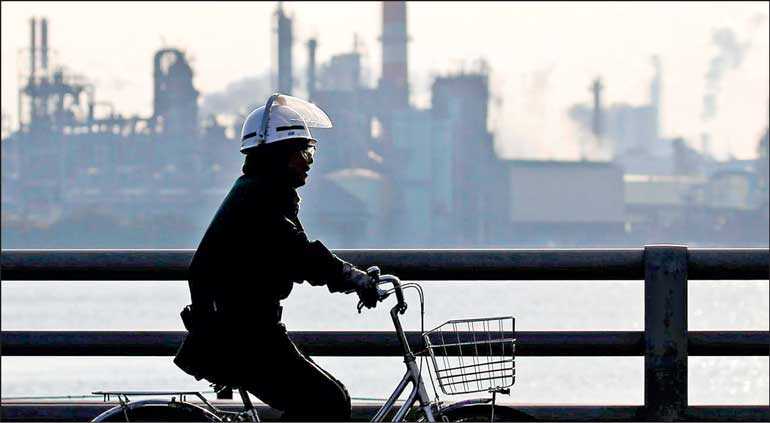Monday Apr 21, 2025
Monday Apr 21, 2025
Friday, 2 August 2019 00:00 - - {{hitsCtrl.values.hits}}

HONG KONG (Reuters): Asian factory activity contracted further in July, fuelling worries that a Sino-US trade war and a slowdown in China could tilt the world toward a global recession, which central banks will have to fight with depleted ammunition.
Purchasing Managers’ Indexes (PMI) showed manufacturing activity contracting in China for a second consecutive month, while export driven economies in North Asia – Japan, South Korea and Taiwan – have been in pain for longer.
Among the emerging market economies of Southeast Asia, Indonesia registered a contraction, but others have benefited from a redirection of trade flows away from China.
Data later in the day is likely to show European manufacturing shrinking as well, while US factories are expected to maintain a modest pace of expansion.
The Federal Reserve cut interest rates on Wednesday, but, reflecting the relative strength of the US economy, Chairman Jerome Powell said the move may not be the start of a lengthy easing campaign. He signalled, however, that the Fed could cut further.
The Bank of Japan and the European Central Bank have flagged their readiness to ease policy in the past week, despite having far less room than the Fed to do so.
“The numbers have been bad for a couple of months already,” said Irene Cheung, Asia strategist at ANZ.
“Things seem to be stabilising a little bit, but they’re not recovering, the trade tensions are still there. We don’t see good news on the growth front yet. We expect (more) interest rate cuts in the region.”
In China, Asia’s economic centre of gravity, the Caixin/Markit Manufacturing PMI for July rose to 49.9 from 49.4 in June, remaining below the neutral 50-mark dividing expansion from contraction on a monthly basis.
The readings were largely in line with an official gauge that showed factory activity last month shrank at a slower-than-expected pace.
Analysts said the numbers reflected some impact of recent stimulus by Chinese authorities, but the manufacturing outlook remained a source of concern as a trade conflict with the United States was expected to drag on.
China’s manufacturing sector may have lost 5 million jobs over the last 12 months, including possibly as many as 1.8-1.9 million due to the trade war, investment bank China International Capital Corp (CICC) said in a report last month.
US and Chinese negotiators ended a brief round of trade talks on Wednesday with little sign of progress and agreed to meet again in September.
The White House and China’s Commerce Ministry each described the meetings in Shanghai as constructive, but neither announced any agreements or goodwill gestures that might have cleared the path to more substantive future talks.
The International Monetary Fund has warned that the trade dispute will shave 0.2% off global output. Many economists say any escalation could lead to a global recession.
“We expect that this downward trend in manufacturing will continue in 2019 until the trade and technology negotiations make some progress,” said Iris Pang, Greater China economist at ING.
While more stimulus from Chinese policymakers is expected down the line, the People’s Bank of China gave no sign of whether it will immediately follow the Fed’s rate cut, as it has done on occasion.
Radiating pain
Elsewhere in Asia, Japanese manufacturing deteriorated for a third month in July, while South Korea’s factory activity contracted further with new export orders shrinking at its fastest pace in nearly six years.
South Korea’s exports, a bellwether for global trade, tumbled for an eighth straight month in July as an escalating political and economic dispute with neighbouring Japan painted an increasingly gloomy picture for Asia’s fourth-largest economy.
Early in July, Japan tightened restrictions on exports to South Korea of key materials used to make memory chips and display panels. Economists say the curbs could shave 0.4 percentage points off South Korea’s GDP this year.
In Taiwan, the streak of contraction reached its 10th month, while Indonesia saw its first below-50 number in six months. Vietnam, Philippines and Thailand saw mildly positive growth.
In Hong Kong, the central bank cut its base rate for the first time in a decade, as its currency peg to the US dollar forces the monetary authority to move in lock-step with the Fed.
The financial hub’s economy grew by a less than expected 0.6% in the second quarter from a year earlier, mainly affected by slower global trade. An increasingly violent cycle of pro-democracy protests in the Chinese-ruled city, however, is beginning to take a heavy toll on retail and tourism and could bring the economy to a halt in coming quarters.
“Eight consecutive weeks of mass protests since early June have already brought immediate disruption to inbound tourist arrivals, retails sales and the property market,” BofA Merrill Lynch analysts said in a note.
“We expect to see more evidence of adverse impact in the third quarter,” they said, adding they revised their full-year growth forecasts to 0.8% in 2019 and 0.7% in 2020, from previous estimates of 2.2% and 2.7%, respectively.